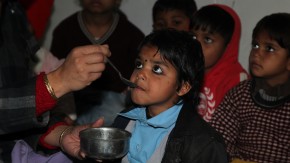
Innovation rarely happens in a straight line. Ideas shift in and out of focus. Discoveries build on other discoveries. Networks multiply the wisdom of their members. And patience isn't just a virtue; it's a requirement.
No one knows these things better than pediatric gastroenterologist Dr. Sean Moore. Dr. Moore's work focuses on the constellation of health and developmental problems caused by a vicious cycle of malnutrition with intestinal infection that scientists call environmental enteric dysfunction, or EED - an unusually elusive subject, as it turns out.
EED is characterized by a chronic, constant inflammation in the small intestine. Over time, this inflammation damages the intestinal barrier, which normally absorbs the nutrients in the food we eat and keeps bad bugs (like those found in contaminated food and water) under control and out of the bloodstream - and reduces the efficacy of oral vaccines for diseases like rotavirus diarrhea and polio. As a result, EED is thought to be one of the key barriers to healthy growth and development for children worldwide.
So far, questions around what to do about EED have not been easy to answer. For one thing, we don't have a clear picture of the disease's biology because EED affects the gastrointestinal tract of undernourished children, and biopsies and endoscopies are expensive and hard to perform in low-resource settings. (Separate grants from the Gates foundation to other teams are working on new technologies to address this.) Also, in places where malnutrition is prevalent, it's hard to sort out where EED is the primary condition and where it's what doctors call a co-morbidity - in other words, to figure out which health problems are caused by EED and which are not.
And so in 2011, Dr. Moore, then a junior faculty member at the University of Cincinnati and the Cincinnati Children's Hospital Medical Center, saw the Grand Challenges Explorations (GCE) call for proposals "Explore Nutrition for Healthy Growth of Infants and Children" and had an idea: Why not build a mouse model that could mimic human environmental enteric dysfunction? The model could be used to test whether and how diet and contaminated water affected EED, and could then test whether EED reduced growth and the effectiveness of oral vaccines - at least, as a start, in lab animals.
Dr. Moore had already used mice to model the effects on the small intestine of a bad diet known as the Regional Basic Diet (a low-fat, low-protein, low-micronutrient composition previously developed in northern Brazil, where childhood undernutrition is now uncommon). The GCE grant he was awarded proposed an extension of this work to better mimic real-world conditions and to probe the causes and consequences of EED in humans. The model is showing promise and is opening up new questions like whether EED is manifested differently in females versus males and which elements of EED might create a predisposition for trans-generational effects.
While giving a talk at the Baylor College of Medicine in Texas, Dr. Moore met Dr. Lanlan Shen, a nutrition scientist at the USDA/Children's Nutrition Research Center. On the theory that aberrant methylation (a process essential for normal development) of DNA might promote the development of colorectal tumors, Dr. Shen had developed a mouse in which a gene called DNA methyltransferase 1 (Dnmt1) is inactivated in its intestinal stem cells. Unfortunately for Dr. Shen, the Dnmt1 knockout mouse had no tumors in its colon. Fortunately for Dr. Moore, it did have symptoms of EED in its small intestine.
This accidental discovery helped Dr. Moore and Dr. Shen make another connection, this time to older work on tropical sprue (a food-malabsorption disorder) in India by Dr. V. I. Mathan. In the mid-1980s, Dr. Mathan's team had proposed that sprue might be caused by a problem with intestinal stem cells - but at the time, they didn't have the tools to test their hypothesis.
Today, however, we know that DNA methylation is a major regulatory factor in epigenetics, or how cells in our body control gene expression. We also know that the B-vitamin folate, a major source of methyl groups for DNA including in gut cells, can be a successful adjunct treatment for sprue. And so Dr. Moore's teams connected the dots. Could we trace the pathogenesis of EED to a lack of the folate-nurtured intestinal stem cells needed to build and maintain a healthy gut lining? This work continues, in part through GCE follow-on funding to Dr. Moore. And his work continues to be a jumping-off point for broader collaborations, including human clinical research with Dr. Asad Ali and collaborators from the Study of Environmental Enteropathy and Malnutrition (SEEM) at Aga Khan University in Pakistan.
Thanks to GCE, Dr. Moore - a junior faculty member when he won that first grant, and now a senior faculty member at the University of Virginia - got what he calls "a foot in the door and a seat at the table advocating for next-generation studies and approaches to be applied to neglected diseases of poverty like EED." And the cycle continues. A young postdoc named Greg Medlock has just joined Dr. Moore's lab and was recently awarded a GCE grant of his own, focused on novel approaches for manufacturing gut microbial biotherapeutics. Now Dr. Medlock, along with dozens of young scientists like him, has his own foot in the door and seat at the table. This is how networks grow, ideas evolve, and innovation thrives.



